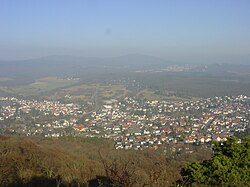Main-Taunus is a Kreis (district) in the middle of Hessen, Germany and is part of the Frankfurt/Rhine-Main Metropolitan Region as well as the Frankfurt urban area. Neighboring districts are Hochtaunuskreis, district-free Frankfurt, Groß-Gerau, district-free Wiesbaden, Rheingau-Taunus. It is the second most densely populated rural district in Germany.
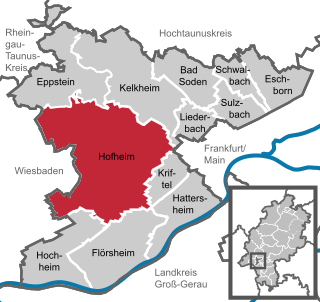
Hofheim is the administrative centre of Main-Taunus-Kreis district, in the south of the German state of Hesse. Its population in September 2020 was 39,946.

Kronberg im Taunus is a town in the Hochtaunuskreis district, Hesse, Germany and part of the Frankfurt Rhein-Main urban area. Before 1866, it was in the Duchy of Nassau; in that year the whole Duchy was absorbed into Prussia. Kronberg lies at the foot of the Taunus, flanked in the north and southwest by forests. A mineral water spring also rises in the town.

Eppstein is a town in the Main-Taunus-Kreis, in Hesse, Germany. Eppstein lies west of Frankfurt am Main, around 12 km north east of the state capital Wiesbaden, and is at the edge of the Taunus mountains. The ruins of the Eppstein castle is a prominent landmark, and houses a museum.
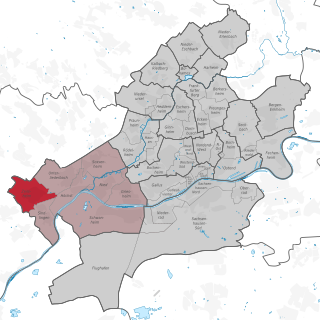
Zeilsheim is a quarter of Frankfurt am Main, Germany. It is part of the Ortsbezirk West and is subdivided into the Stadtbezirke Zeilsheim-Ost, Zeilsheim-Süd and Zeilsheim-Nord.

Königstein im Taunus is a health spa and lies on the thickly wooded slopes of the Taunus in Hesse, Germany. The town is part of the Frankfurt Rhein-Main urban area. Owing to its advantageous location for both scenery and transport on the edge of the Frankfurt Rhine Main Region, Königstein is a favourite residential town. Neighbouring places are Kronberg im Taunus, Glashütten, Schwalbach am Taunus, Bad Soden am Taunus and Kelkheim.

Niedernhausen im Taunus is a municipality in the Rheingau-Taunus-Kreis in the Regierungsbezirk of Darmstadt in Hesse, Germany, with almost 15,000 inhabitants.

Kelkheim, officially "Kelkheim (Taunus)", is a town in the Main-Taunus district in Hesse, Germany, close to Germany's financial center Frankfurt/Main.

Schwalbach am Taunus, a town in the Main-Taunus-Kreis district, in Hesse, Germany, population about 14,000, is a dormitory town to Frankfurt, situated some 11 km east of Schwalbach. There is evidence of human habitation dating back to Neolithic times, and recorded history going back to 781 AD. Until the end of the Second World War, it was a farming village, but in the post-war era it expanded rapidly and became economically linked to Frankfurt. Schwalbach was granted Gemeinde (municipal) status in 1970.

Bad Camberg is, with 14,500 inhabitants, the second largest town in Limburg-Weilburg district in Hesse, Germany, as well as the southernmost town in the Regierungsbezirk of Gießen. It is located in the eastern Taunus in the Goldener Grund some 30 km north of Wiesbaden, 18 km southeast of Limburg an der Lahn, and 44 km northwest of Frankfurt, as well as on the German Timber-Frame Road. Bad Camberg is the central community of the Goldener Grund with good infrastructure, and a lower centre partly with a middle centre's function.
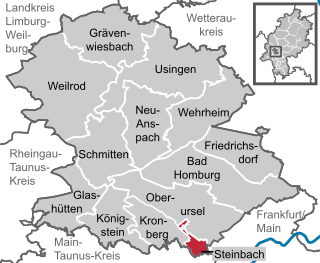
Steinbach is a town in the Hochtaunuskreis that borders Frankfurt am Main to the east. Other neighbouring towns are Oberursel, Kronberg im Taunus and Eschborn. It is in the German state of Hesse.

Glashütten is a small municipality in the Hochtaunuskreis. This community in the Taunus, which is made up of the three formerly independent communities of Glashütten, Schloßborn and Oberems, lies in the Hochtaunus Nature Park, not far from Königstein im Taunus, Germany.
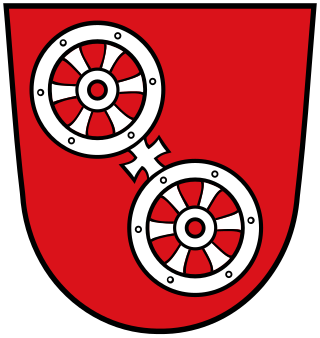
The Wheel of Mainz or Mainzer Rad, in German, was the coat of arms of the Archbishopric of Mainz and thus also of the Electorate of Mainz (Kurmainz), in Rhineland-Palatinate, Germany. It consists of a silver wheel with six spokes on a red background. The wheel can also be found in stonemasons' carvings and similar objects. Currently, the City of Mainz uses a double wheel connected by a silver cross.

The Taunus Railway is a double-track electrified railway line, which connects Frankfurt and Wiesbaden, Germany. It is 41.2 km long and follows the course of the Main on its north side, running quite close to it in some places. Its first stage was opened in September 1839 and is thus the oldest railway line in the German state of Hesse and one of the oldest in Germany. Today it is used by Regional-Express trains between Frankfurt and Wiesbaden and the trains of line S1 of the Rhine-Main S-Bahn between Frankfurt-Höchst and Wiesbaden. Between Frankfurt Hbf and Frankfurt-Höchst, they run on the line of the former Hessian Ludwig Railway.

Bundesstraße 455 is a German Bundesstraße in the federal state of Hesse. The route runs southwest from Schotten in Vogelsbergkreis to Mainz-Kastel, a borough of the Hessian capital city of Wiesbaden.

The Frankfurt-Höchst station is an important station in the Frankfurt district of Höchst and is the second largest station in the city with twelve tracks. It is currently mainly used by S-Bahn, suburban and regional services. It is the most important public transport node in western Frankfurt.
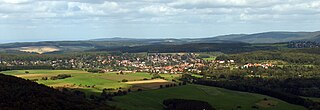
Schloßborn (Schlossborn) is a village in the municipality of Glashütten, Hesse, Germany. It is located northeast of Wiesbaden and northwest of Frankfurt in the hilly Taunus region.
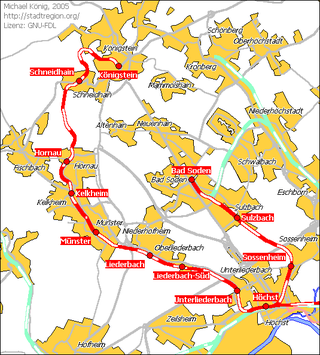
The Königstein Railway is a 1902 opened, single-track and non-electrified secondary railway line that connects the town of Königstein im Taunus with the city of Frankfurt am Main on the southern edge of the Taunus in the German state of Hesse.

Kelkheim station is the most important station on the Königstein Railway from Höchst to Königstein on the western edge of Frankfurt am Main in the German state of Hesse. It is the location of the scheduled train crossings on the single track line. It is the middle one of three stations in the town of Kelkheim and serves the districts of Kelkheim-Mitte and Fischbach.

Rettershof is a crown domain northeast of Fischbach, a district of Kelkheim in the Vordertaunus. It goes back to a former Premonstratensian monastery. From the 12th century until 1559, nuns were resident at Retters, and later various owners used the estate and its lands as a farmstead. Today, in addition to its continued agricultural use, Rettershof is a popular regional excursion destination.
